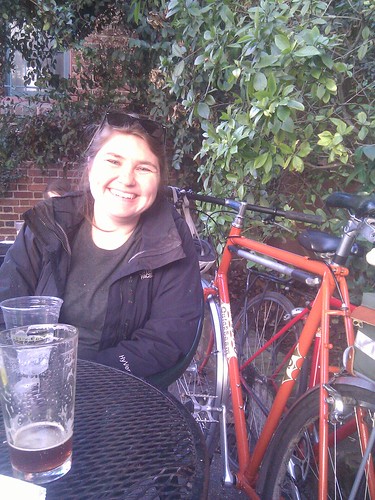
The Quickbeam felt very good, riding in the environment in which it was conceived, the flat streets and trails of Sacramento. The riding position was entirely comfortable in street clothes, not requiring bike clothes like the old stretched-out position on the Casseroll did. The gearing felt a little bit on the high side, but that I think was mostly because we were heading into the wind for the first part of the ride. Ah, the wind--Sacramento's substitute for hills. However, I felt like I finally ran up against the Quickbeam's limitations for long, steady riding. My feet, in my Adidas on the MKS Touring Lite pedals with Power Grips, started to feel a bit numb. Riding in jeans definitely isn't as comfortable as bike clothes. My hands, my arms, and my torso never hurt, but definitely were feeling tired from being limited to basically one position, one arrangement. As we rolled up to our very pleasant stop in Midtown and I got off, my hands felt a little bit numb as the pressure on my palms was relieved.
Normally--even if I had been in a different mind state today--I would have worried about this, thinking about things to change about my bike fit to "fix" the little problems I had. But I feel like I was able to step back and realize that on the whole, the Quickbeam was basically performing as it should. I never felt unbalanced, like I had excessive pressure on my hands. Yes, I felt some discomfort a fatigue, but I think most of them were from doing a long, steady ride (which basically describes all of the riding in Sacramento, and very little of the riding in Berkeley) without much change in position--not from something being "wrong" with the bicycle.
Sure, the lack of variety of hand and torso positions had me thinking about different bars that would give more variety, and I've been even thinking over in my head what a drop bar configuration for the Quickbeam would look like. But then I realized that I do have a bicycle with good, multi-position drop bars, and multiple gears for maximizing efficiency for terrain and wind condition--my road bike, the Casseroll. The new position tweaks for it mean that bikes clothes aren't required for riding it comfortably, and flat pedals would even obviate the need for bike shoes.
Long steady rides aren't necessarily what the Quickbeam is for. It's for short blasts across town, running errands with lots of stop and start, short climbs. Or, maybe now with starting to think about using it for longer, hilly rides, it will do longer stuff, but still things which by their varied terrain also vary how I'm sitting on the bike. The limitations of flat bars aren't really a limitation, for now.
In its conception, the Quickbeam has a philosophical or aesthetic function in my bicycle quiver: it's a fixed gear. Fixed gears for me are about accepting the limitations of the bicycle, asking yourself to do more with less things, in return for mechanical robustness and simplicity. In this configuration, it makes sense to have not just a single gear but also simple, flat handlebars. Yes, riding a single gear bicycle with only one real hand position quickly makes you aware of the limitations of such as setup, but perhaps being aware of and accepting the limitations of the machine is a good thing.
All too often, especially when they are constructed and acquired with significant expense and effort, I can come to expect too much of my bicycles. I want them to make pedaling effortless, to smooth the path in front of me, to comfort my weary and fallible body and mind. And while riding a well designed and constructed bicycle is truly a joy, it's good for me to remember that at the end of the day it is just an arrangement, an assemblage of steel tubes, aluminum bars, and rubber tires. Sometimes it can be comfortable, sometimes it can be uncomfortable, but as long as I keep pedaling, it will move forward. Riding a simple bike helps me remember that.
----
What is a partially connected cyborg approach to bike fit? To begin with, I think it has to recognize bike fit as a form of situated knowledge. No matter how much I ride, my knowledge is enacted through my situation as a bloody bundle of nerves and neuroses, connected physically, mentally, and emotionally to an existing assemblage of steel, aluminum, and rubber tubes. It can only know what is is possible to experience, to embody as part of this assemblage. Like scientists wishing to transcend the embodied practice of observation, I have been wishing to transcend the embodied practice of riding, controlling a bicycle. But what if if I give up the idea of transcendence?
Then I've learned a lot already. Everything is where it should be. My nerves being sore from a long ride on flat bars is no longer a cause for concern, a challenge that my knowledge and engineering isn't sufficient to have achieved transcendence, but rather a gentle reminder of my embodiment, my close relationship with my bicycle.
No comments:
Post a Comment